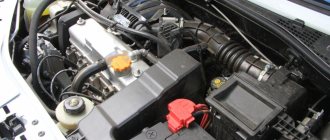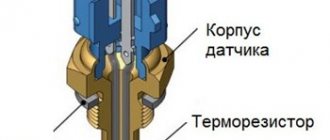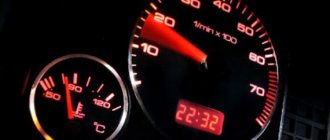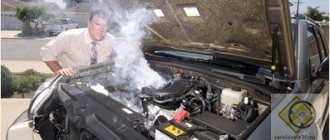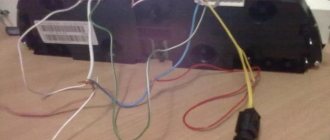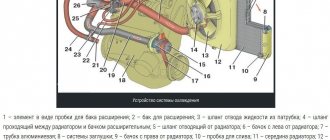Characteristics of the internal combustion engine VAZ 11183
| Characteristics of VAZ internal combustion engine | 11183 | 11183-50 |
| Serial production period, years | 2004-2017 | 2011-2017 |
| Type by cylinder arrangement | In-line (cylinders in 1st row) | |
| Cylinders | four | |
| Valves | eight | |
| Working volume, cm³ | 1596 | |
| Diam. cylinders, mm | 82 | |
| Piston stroke, mm | 75.6 | |
| Cylinder operating order | 1→3→4→2 | |
| Fuel supply | Injection, from four injectors in the intake manifold | |
| Intake manifold (receiver) | made of plastic, electronically controlled throttle body | |
| An exhaust manifold | together with the catalyst | |
| Max. power, hp | 80 | 82 |
| Max. torque, Nm | 120 | 132 |
| Compression ratio | 9.6 – 9.8 | 9.8 – 10 |
| Fuel type | AI 92-95 | |
| Amount of oil in the lubrication system, l | 3,5 | |
| Oil used in internal combustion engines | 5W-30, 5W-40 | |
| Gearbox oil filling volume, l | 3 | |
| Oil used in gearbox | 75W80, 75W90, 80W85, 80W90, 85W90 | |
| Environmental standards | EURO 2/3 | EURO 4 |
| Application on VAZ cars | Kalina, Granta, 21101, 21112, 21121, 2113, 2114, 2115. | |
| Resource, km | 150 000 | |
| Weight, kg | 112 | |
Description
As you know, any Priora and Kalina have a cooling system that ensures normal engine operation and helps prevent overheating. One of the devices that allows you to cool the power unit is a fan sensor, upon the signal of which the ventilation device should turn on. On Kalina, this controller is designed to activate the fan when the engine temperature reaches a certain point. Thanks to the fan, which must turn on based on a signal from the controller, the engine temperature will always be normal and will not exceed the permissible threshold. If the device does not work, the fan will not turn on, and the engine may overheat.
Lada Kalina Cross (2019). The engine is overheating (the engine overheating warning light is on)
Lada Kalina Cross (2019). The engine is overheating (the engine overheating warning light is on)
| List of possible faults | Diagnostics | Elimination methods |
| Thermostat is faulty | Check that the thermostat is working properly | Replace the faulty thermostat |
| Insufficient coolant | The fluid level is below the “MIN” mark on the expansion tank | Fix leaks. Add coolant |
| Lots of scale in the cooling system | — | Clean the cooling system with a descaling agent. Do not use hard water in the cooling system. Dilute concentrated antifreeze only with distilled water. |
| Radiator cells are dirty | Inspection | Flush the radiator with pressurized water |
| Coolant pump faulty | Remove the pump and inspect the assembly | Replace the pump assembly |
| Cooling fan does not turn on | Check the fan circuits | Restore contact in electrical circuits. Faulty fuse, relay, cooling fan, temperature sensor, ECU - replace |
| Unacceptably low octane number of gasoline | — | Fill your car with fuel recommended by the manufacturer |
| A lot of carbon deposits in the combustion chambers, on the piston heads, valve plates | Inspection after removing the engine cylinder head | Eliminate the cause of carbon formation (see faults “Increased fuel consumption”, “Increased oil consumption”). Use oil of the recommended viscosity and, if possible, low ash content. |
| Exhaust gas breakthrough into the cooling system through a damaged cylinder head gasket | There is a smell of exhaust gases in the expansion tank and bubbles float to the surface | Replace the cylinder head gasket. Check for flatness of the cylinder head |
Causes of engine overheating
1. Lack of fluid
The most common cause of overheating is insufficient coolant in the cooling system. Liquid, as you know, will always find a way to leak out if there is even the slightest hole. In a cooling system with a bunch of tubes, pipes, clamps and gaskets, there may be several such holes. So the antifreeze gradually leaves both the expansion tank and the radiator of the cooling system. READ ALSO: How to protect yourself and your car from heat and sun This problem can be identified by white streaks on the outer surfaces of the engine, drops of antifreeze under the car after a long period of parking. All leaking elements of the cooling system must be replaced.
2. Problems with the radiator
If the fan is driven by a belt from the crankshaft, the tension of this belt may weaken. If the fan drive is electric, the temperature sensor may malfunction. Check these elements - they often provoke further problems. Then make sure the cooling system radiator fins are kept clean. If dirt has stuck to them, then overheating will occur very quickly - it is best to wash the radiator with a strong stream of water once every 2-3 years. READ ALSO: How to prepare your car for the start of the hot season
3. Problems with the thermostat
As deposits accumulate in the cooling system, the mobility of the elastic element of the thermostat is lost, and it stops responding to the temperature of the antifreeze leaving the engine. Then it all depends on the position in which it hangs - either it will constantly begin to drive liquid along a large circuit, and the engine will be more difficult to warm up; or in small ways, then overheating is inevitable. Very often, the thermostat jams after tap water has been poured into the cooling system - it is hard, with a high content of salts and minerals, which are immediately deposited in the cooling system. If you had to do this, then you need to replace it with antifreeze as quickly as possible. But you still need to carry water with you: you often have to urgently add coolant (preferably distilled). A faulty thermostat needs to be replaced urgently. But if it is expensive, then at least wash it by pouring a hot mixture of water and citric acid, Calgon or “Mole” into the cooling system - these substances clean well and dissolve everything unnecessary.
What to do if you overheat
Causes that can be identified and some that can be eliminated
Combustion chamber seal failure
What not to do when the engine is boiling
Prevention
In addition, overheating of the engine can occur if the wrong mode of operation of the motor is selected. For example, if you constantly drive only in lower gears and at high speeds, then the likelihood of the engine boiling increases, especially if there are deviations in the operation of the cooling system. In the cold season, some errors are not affected by low temperatures, but this does not mean that engines boil only in the summer.
At what temperature does the fan turn on?
Lately I have to drive my Kalina quite rarely, and I noticed a peculiarity that the fan does not turn on at all.
Although you have to stand in traffic jams, and the temperature outside is above +30 degrees. We began to have doubts about the performance of the fan or the electrics responsible for its operation. I decided to check everything at idle when the car was parked. I started it up and waited until the engine warmed up to a high temperature. At this time, I opened the hood and began to observe the fan. After about 20 minutes of engine operation, the coolant temperature gauge needle approached 100 degrees, but the fan still did not want to turn on.
I already thought that something was wrong with the car, but as soon as the needle rose slightly above 100 degrees (about 102) , the fan started working, and I breathed a sigh of relief. The photo above shows exactly the moment it was turned on. After reading specialized forums, I came to the conclusion that this temperature should be in order to send a signal from the ECU.
I also came across quite a lot of opinions that it is better to set a lower response threshold, for example, using the “Tropic” mode on the “State” on-board computer. It is possible that in some cases this will be justified, but I think that constantly turning on this mode will not lead to anything good. Moreover, in the summer the engine often heats up to 95-98 degrees and this temperature can be considered normal. And if the blades start spinning when such a threshold is reached, then the electric motor will definitely not work in this mode for a long time.
It is very difficult to overheat the engine when the fan is operating normally. Although there was one case with my Kalina, when in abnormal heat (+42 in the shade) I had to trudge a couple of kilometers behind a scraper. I mentioned this incident once. After reaching the critical temperature, a constant long sound signal from the instrument panel is triggered and the warning lamp lights up. At this moment, a signal is sent to the standard BC and it records error 6. You can read more about this here: Error codes of the on-board computer and self-diagnosis of the instrument panel.
In my case, after the overheating alarm went off, I immediately managed to drive out onto a flat section of the road and the needle immediately dropped to the normal level. Thank God, there were no consequences for the engine, but it is better to avoid such situations.
Source
Operating temperature of 8-valve
The normal operating temperature for eight-valve engines on Kalinas and Grants is exactly 90 ºC . But owners complain that sometimes it has difficulty reaching 80 degrees even in warm weather. The reason lies in the thermostat - it opens fully at a temperature of 85 degrees. Moreover, the permissible deviation from this value is very large - ( 85±8.3 ) ºС.
In other words, the run-up is 77..93ºС .
But the fuel mixture can only ignite normally if the engine temperature is about 90 degrees . This is the value stored in the electronic control unit. If the temperature is too low, the mixture becomes richer (the amount of gasoline increases). This is the main problem that occurs when the temperature drops. And in winter the heater works worse.
Your case
Temperature diagram . Normal operating temperature is at 90 on the instrument panel.
In your case, the thermostat is most likely stuck, usually stuck in the middle. In this case, either repairing or replacing the thermostat will help.
A stuck thermostat valve is a typical malfunction of the engine cooling system.
That is, the liquid that has not yet been heated is supplied to the cooling radiator and blown by a strong wind flow. Indeed, with an increase in air temperature, the problem will partly go away. That’s why they used to put cardboard on it and drive like that for years. But we don't recommend doing this.
Solution
The problem of low temperature of the engine cooling system can be eliminated by installing a thermostat that opens at 92ºС . The WAHLER 3091.92D element performs excellently .
You just have to disassemble it and transfer the inside to Kalina’s original thermostat.
There is a downside: in summer the temperature will be higher, and there is a risk of boiling in a traffic jam. To be more precise, this risk is higher when installing a thermostat with a late opening time!
Be sure to use new gaskets and lubricate them with a small amount of sealant - this will prevent coolant leaks.
How to check the sensor
DTOZH for Kalina has catalog article 23.3828; checking the element is mandatory if gasoline consumption increases and difficulties are observed when heating the engine. An enriched mixture will always flow into the cylinders, the radiator cooling fan will constantly work, which will lead to rapid wear.
If the element transmitting signals to the instrument panel fails, the indicator needle will stop moving and remain at zero.
Check the dismantled assembly with a multimeter by placing the element in a container (kettle, pan) with boiling water. As the liquid cools, the instrument readings will increase. How to check step by step:
- Remove the unit from the car.
- Set the multimeter to the ohmmeter position in the range of 100 Ohm–10 kOhm.
- Connect the DTOZH outputs to the multimeter, lower it into boiling water, with the terminals located outside, only the head of the element is lowered into the boiling water, which in working condition comes into contact with the antifreeze or antifreeze in the system.
- Check the table for the relationship between winding resistance and ambient temperature.
| Temperature, °C | Resistance, Ohm |
| −40 | 100700 |
| −20 | 28680 |
| −10 | 16180 |
| 9420 | |
| +5 | 7280 |
| +10 | 5670 |
| +15 | 4450 |
| +20 | 3520 |
| +25 | 2796 |
| +35 | 1802 |
| +45 | 1188 |
| +60 | 667 |
| +80 | 332 |
| +100 | 177 |
Checking the sensor that transmits temperature to the dashboard is carried out in the same way. The ohmmeter readings may differ from those indicated by 15–29 units.



